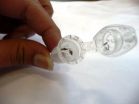New species of multi-horned dinosaurs unearthed in Utah
With looks that kill, 2 newly discovered dinosaur species once roamed lost continent in what is now southern Utah
2010-09-24
(Press-News.org) "A giant rhino with a ridiculously supersized head."
"Fifteen long, pointed sideways oriented eye horns: one over the nose, one atop each eye, one at the tip of each cheek bone, and ten across the rear margin of the bony frill."
"A horned face: large horn over the nose and short, blunt eye horns that project strongly to the side."
Such phrases have been used to describe two newly discovered species of dinosaurs with looks only a mother could love. Still, they are drawing the attention and inspiring the imagination of scientists and lay people alike.
Announced today in PLoS ONE, the online open-access journal produced by the Public Library of Science, two new species of horned dinosaurs--Utahceratops gettyi and Kosmoceratops richardsoni--have been found in Grand Staircase-Escalante National Monument in southern Utah. Close relatives of the famous Triceratops, these giant plant eaters were once inhabitants of the "lost island continent" of Laramidia, a swampy, subtropical setting formed when a shallow sea flooded the central region of North America, isolating the eastern and western portions of the continent for millions of years during the late Cretaceous period.
"My enthusiasm for these findings is threefold," said Raymond Bernor, program director of the Sedimentary Geology and Paleobiology Program at the National Science Foundation (NSF). "First, researchers discovered two new, exciting dinosaur species. Second, the research has accomplished a major advance in understanding the biogenographic provinciality of Western North American dinosaur communities that apparently included separate northern and southern populations. And third, this discovery has inspired future discoveries in the Grand Staircase-Escalante National Monument, which has now emerged as one of the most important paleontological reserves in the world."
But what about these ugly, horned creatures … Although much speculation has ensued about the function of the ceratopsian horns and frills of these prehistoric monsters--from fighting off predators to recognizing other members of the same species or controlling body temperature--the dominant idea today is that these features functioned first and foremost to enhance reproductive success. Scott Sampson, first author on the paper, explains, "Most of these bizarre features would have made lousy weapons to fend off predators. It's far more likely that they were used to intimidate or do battle with rivals of the same sex, as well as to attract individuals of the opposite sex."
###
More details are available in a press release from the Utah Museum of Natural History.
View a video discussing the two new species of dinosaur.
END
ELSE PRESS RELEASES FROM THIS DATE:
2010-09-24
COLUMBUS, Ohio – While birds living in urban areas face more predators than do those in rural areas, that doesn't mean urban birds face more danger from nest robbers.
A six-year study conducted in 19 central Ohio forests from 2004 to 2009 found that, as expected, rural areas that had higher numbers of nest predators such as raccoons, domestic cats, and crows, also showed lower rates of nest survival.
But there was no relation between the number of predators and nest survival in more urbanized areas.
Researchers believe that's because nest predators in urban areas ...
2010-09-24
WASHINGTON -- A concerted effort to boost research on women's health over the last two decades has lessened the burden of disease and reduced deaths among women due to cardiovascular disease, breast cancer, and cervical cancer, says a new report from the Institute of Medicine. The effort has yielded less but still significant progress in reducing the effects of depression, HIV/AIDS, and osteoporosis on women, added the committee that wrote the report.
However, several health issues important to women have seen little progress, including unintended pregnancy, autoimmune ...
2010-09-24
WASHINGTON -- A decade-long, multibillion dollar effort to restore the Florida Everglades has made tangible albeit slow progress, but additional projects need completion before substantial benefits are seen, says a new congressionally mandated report from the National Research Council. Challenges in achieving targets for both water quality and water flow have become more apparent, requiring further scientific analysis to determine the repercussions of trading off one for the other. Although important scientific advances have been made, continued decline of some aspects ...
2010-09-24
Treatment with vitamin C rapidly improves the emotional state of acutely hospitalized patients, according to a study carried out by researchers at Montreal's Jewish General Hospital (JGH) and the affiliated Lady Davis Institute for Medical Research (LDI).
In a double-blind clinical trial, patients admitted to the JGH were randomly assigned to receive either vitamin C or vitamin D supplements for seven to ten days. Patients administered vitamin C had a rapid and statistically and clinically significant improvement in mood state, but no significant change in mood occurred ...
2010-09-24
New Haven, Conn.—Scientists have wondered for some time why certain seismic waves travel more quickly through the core-mantle boundary, a thin layer of the Earth's interior that lies between about 1675 and 1800 miles below the surface. Now a new study by Yale University and the University of California, Berkeley sheds light on the mystery by showing how this region behaves under the extreme conditions found so deep in the Earth. The findings, which appear in the Sept. 24 issue of the journal Science, have important implications for understanding how the Earth's internal ...
2010-09-24
Psychologists have known for a long time that after you make a choice, you adjust your opinion to think better of the thing you chose. Now a new study has found that this is true even if you don't know the options that you're choosing between.
People change their minds about a choice after they make it. If you ask someone how he feels about Athens and Paris, he might rate them the same. But after you make him choose one as a vacation destination, he'll rate that city higher. This is thought to be a way to reduce the psychological tension that is created by rejecting ...
2010-09-24
Across the globe, the diversity of plant and animal species generally increases from the North and South Poles towards the Equator but surprisingly that rule isn't true for soil bacteria, according to a new study by Queen's University biology professor Paul Grogan.
"It appears that the rules determining the patterns for plant and animal diversity are different than the rules for bacteria," says Professor Grogan.
The finding is important because one of the goals in ecology is to explain patterns in the distribution of species and understand the biological and environmental ...
2010-09-24
A new technique pioneered at Liverpool School of Tropical Medicine (LSTM) is improving the detection and monitoring of insecticide resistance in field populations of an important malaria-carrying mosquito.
Researchers at LSTM, led by Dr Charles Wondji have developed a new technique which encourages the female Anopheles funestus mosquitoes to lay eggs which are then reared into adult mosquitoes to provide sufficient numbers to determine levels of insecticide resistance and to characterise the underlying mechanisms.
Explaining the significance, John Morgan, who designed ...
2010-09-24
Researchers at Mount Sinai School of Medicine have found that the costs of care for patients with cancer who disenrolled from hospice were nearly five times higher than for patients who remained with hospice. Patients who disenroll from hospice are far more likely to use emergency department care and be hospitalized. The results are published in the October 1 issue of the Journal of Clinical Oncology.
Led by Melissa D.A. Carlson, PhD, Assistant Professor of Geriatrics and Palliative Medicine, and Elizabeth H. Bradley, PhD, Professor of Public Health at Yale University, ...
2010-09-24
A non-stick coating for a substance found in semen dramatically lowers the rate of infection of immune cells by HIV a new study has found.
The new material is a potential ingredient for microbicides designed to reduce transmission of HIV, a team from the University of Rochester Medical Center and the University of California, San Diego reports in a forthcoming issue of the Journal of Biological Chemistry.
The coating clings to fibrous strings and mats of protein called SEVI–for semen-derived enhancer of viral infection–which was first discovered just three years ago. ...
LAST 30 PRESS RELEASES:
[Press-News.org] New species of multi-horned dinosaurs unearthed in Utah
With looks that kill, 2 newly discovered dinosaur species once roamed lost continent in what is now southern Utah

